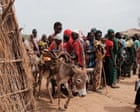
In a world striving for peace, recent events across several regions have drawn significant global attention, underscoring ongoing struggles and aspirations for stability. Each situation reflects complex dynamics that impact not only the local populations but also carry broader geopolitical significance.
In Sudan, the ongoing civil war has seen troubling developments, as the Rapid Support Forces (RSF), a paramilitary group, has been accused of violent actions in the North Kordofan state. Nearly 300 individuals have reportedly lost their lives in these attacks, according to Sudanese activists. The region has been a focal point in the civil war that has continued since April 2023, illustrating the severe impacts on communities caught in the crossfire. The RSF’s actions, targeting areas described as devoid of military objectives, have intensified the dialogue on the humanitarian implications of the conflict.
Meanwhile, in Ukraine, the narrative is shaped by international alliances and military strategies. Former U.S. President Donald Trump has confirmed a new weapons deal for Ukraine, highlighting a cooperative stance with NATO allies amid increasing tensions with Russia. The announcement comes with a stern warning: the imposition of severe tariffs on Russia should the war persist beyond a specified period. Within Ukraine, efforts by Ukrainian intelligence have reportedly led to the neutralization of members of Russia’s Federal Security Service implicated in the killing of a Ukrainian colonel. This development underscores the ongoing intelligence and military maneuvers in the region’s conflict landscape.
In the Middle East, Israel’s military actions against Syria reflect the complexity of regional power struggles. Israeli forces have targeted military sites in southern Syria amid escalating clashes between Druze militias and Bedouin tribes. The violence has resulted in numerous casualties and further complicated Syria’s path to post-civil war stability. As government forces engage with various local factions, the need for diplomatic engagement and conflict resolution becomes increasingly apparent.
The Gaza Strip remains a poignant symbol of prolonged conflict and humanitarian crises. Recent escalations in Israeli airstrikes have resulted in a significant loss of life, with Gaza’s health ministry reporting over 58,000 deaths since the beginning of hostilities. Among the deceased, a large number are women and children, highlighting the dire humanitarian conditions faced by affected populations. A tragic incident involving an Israeli airstrike at a water collection point took the lives of several children, further emphasizing the urgent need for dialogues that address both security concerns and humanitarian aid.
As these regions grapple with unrest, the international community’s response becomes crucial in fostering pathways to peace and recovery. The intricate interplay of military strategies, political alliances, and humanitarian considerations presents a complex landscape. However, it also invites collective efforts to pursue lasting solutions, recognizing the shared responsibilities and commitments to global peace and stability. Through understanding and mindful engagement, the hope remains for transformative actions that can alleviate suffering and build bridges for a more harmonious future.
Source: {link}
